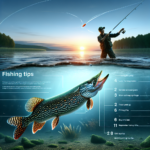Fishing Tips on How to Catch Grass Carp

Introduction
Grass carp, also known as white amur, are a popular target for sport and recreational fishing due to their size, strength, and the challenge they present to anglers. Native to East Asia, these fish have been introduced to various parts of the world for aquatic weed control. This article will provide a comprehensive guide on how to catch grass carp, covering their physical characteristics, habitat, behavior, optimal fishing times, effective techniques, recommended gear, best locations, common mistakes to avoid, and catch and release tips.
Fish Species Overview
Description
Grass carp are large, torpedo-shaped fish with a broad, flat head and a slightly forked tail. They have a silvery to olive-green coloration on their back, which fades to a lighter, silvery-white on their belly. Adult grass carp can grow up to 4 feet in length and weigh over 70 pounds, although most caught by anglers are typically between 10 to 30 pounds.
Habitat
Grass carp prefer freshwater environments such as rivers, lakes, and ponds with abundant vegetation. They are commonly found in slow-moving or still waters with plenty of aquatic plants, which they feed on. Grass carp have been introduced to various regions worldwide, including North America, Europe, and Asia, primarily for their ability to control aquatic weeds.
Behavior
Grass carp are herbivorous and primarily feed on aquatic vegetation, although they may occasionally consume insects and other small organisms. They are most active during the warmer months when water temperatures are between 68°F and 86°F. Grass carp spawn in the spring and early summer, typically in fast-flowing rivers with gravel or sandy bottoms. They are known for their strong, fast runs when hooked, making them a challenging and exciting catch for anglers.
Challenges
One of the main challenges anglers face when targeting grass carp is their wariness and sensitivity to disturbances. They are easily spooked and can be difficult to approach. Additionally, their herbivorous diet means that traditional baits used for other fish species may not be effective. Understanding their behavior and preferences is crucial for successful grass carp fishing.
Best Time to Catch Grass Carp
Seasonal Considerations
The best time to catch grass carp is during the warmer months, from late spring to early fall. During this period, water temperatures are ideal for their activity, and they are more likely to be feeding actively. Late spring and early summer are particularly good times, as grass carp are more likely to be found in shallower waters during their spawning season.
Time of Day
Grass carp are most active during the early morning and late afternoon when water temperatures are cooler. These times of day also offer lower light conditions, which can make grass carp less wary and more likely to bite. Midday fishing can also be productive, especially in shaded areas or on overcast days.
Weather Conditions
Ideal weather conditions for grass carp fishing include calm, overcast days with mild temperatures. Grass carp are more likely to be feeding actively under these conditions. Avoid fishing during extreme weather conditions, such as heavy rain or strong winds, as these can make grass carp more difficult to locate and catch.
Top Fishing Techniques for Grass Carp
Technique 1: Still Fishing with Vegetation Baits
One of the most effective techniques for catching grass carp is still fishing with vegetation baits. Use a simple rig with a hook baited with aquatic plants, such as watercress, lettuce, or corn. Cast your bait near areas with abundant vegetation and wait for the grass carp to come to you. This technique works well because it mimics the natural feeding behavior of grass carp.
Technique 2: Chumming and Baiting
Chumming involves scattering small amounts of bait in the water to attract grass carp to your fishing spot. Use a mixture of corn, bread, or other plant-based baits to create a feeding area. Once the grass carp are attracted to the chum, use a similar bait on your hook to catch them. This technique can be particularly effective in areas with low vegetation.
Technique 3: Fly Fishing
Fly fishing for grass carp can be a rewarding challenge for experienced anglers. Use large, green flies that mimic aquatic plants or insects. Cast your fly near vegetation and use a slow, steady retrieve to entice grass carp to bite. This technique requires precision and patience but can be highly effective in clear, shallow waters.
Pro Tips
- Use light tackle to avoid spooking grass carp.
- Be patient and avoid making sudden movements or loud noises.
- Experiment with different baits and techniques to find what works best in your fishing location.
- Observe the behavior of grass carp in your fishing area to better understand their feeding patterns.
Recommended Gear for Catching Grass Carp
Fishing Rod and Reel
For grass carp fishing, use a medium to heavy spinning or baitcasting rod with a fast action tip. A rod length of 7 to 9 feet is ideal for casting long distances and handling the strong runs of grass carp. Pair your rod with a high-quality spinning or baitcasting reel with a smooth drag system to handle the powerful runs of grass carp.
Fishing Line
Use a strong, abrasion-resistant fishing line with a test strength of 15 to 30 pounds. Braided line is a good choice for its strength and sensitivity, while fluorocarbon line offers excellent abrasion resistance and low visibility in clear water. A line length of 150 to 200 yards is recommended to handle the long runs of grass carp.
Hooks and Baits
Use size 4 to 1/0 hooks for grass carp fishing. Circle hooks are a good choice as they reduce the risk of deep hooking and make catch and release easier. For baits, use plant-based options such as corn, bread, lettuce, or aquatic plants. Experiment with different baits to find what works best in your fishing location.
Additional Gear
- Bobbers: Use bobbers to keep your bait at the desired depth and detect bites.
- Sinkers: Use small sinkers to keep your bait in place, especially in flowing water.
- Leaders: Use fluorocarbon leaders to reduce visibility and increase your chances of a bite.
- Landing Net: Use a large, sturdy landing net to safely land grass carp.
Best Locations to Find Grass Carp
General Locations
Grass carp are commonly found in freshwater bodies such as lakes, rivers, and ponds with abundant vegetation. Look for areas with slow-moving or still waters and plenty of aquatic plants, as these are prime feeding grounds for grass carp.
Specific Regions
In North America, popular spots for grass carp fishing include the Mississippi River, the Great Lakes, and various reservoirs and ponds in the southern United States. In Europe, grass carp can be found in rivers and lakes in countries such as France, Germany, and the United Kingdom. In Asia, grass carp are commonly found in rivers and lakes in China, Japan, and Korea.
Common Mistakes to Avoid
Mistake 1: Using the Wrong Bait
Grass carp are herbivorous and prefer plant-based baits. Using traditional baits such as worms or minnows is unlikely to be effective. Instead, use baits such as corn, bread, lettuce, or aquatic plants to attract grass carp.
Mistake 2: Fishing in the Wrong Location
Grass carp prefer areas with abundant vegetation. Fishing in areas with little or no vegetation is unlikely to yield results. Look for areas with plenty of aquatic plants and slow-moving or still waters.
Mistake 3: Being Too Noisy
Grass carp are easily spooked by loud noises and sudden movements. Be patient and avoid making unnecessary noise or movements while fishing. Approach your fishing spot quietly and make gentle casts to avoid scaring away grass carp.
Catch and Release Tips
Importance of Conservation and Ethical Fishing Practices
Practicing catch and release is important for the conservation of grass carp populations and the overall health of aquatic ecosystems. By releasing grass carp back into the water, anglers can help maintain healthy fish populations and ensure future generations can enjoy the sport.
Proper Handling Techniques
To ensure the survival of grass carp after release, handle them with care. Use a wet towel or gloves to hold the fish and avoid touching their gills or eyes. Remove the hook gently using pliers or a hook remover. If the fish is deeply hooked, cut the line close to the hook and leave it in place. Release the fish gently back into the water, supporting it until it swims away on its own.
Legal Considerations
Before fishing for grass carp, check local regulations regarding size limits, bag limits, and any special permits required. Some areas may have restrictions on catching and releasing grass carp due to their role in aquatic weed control. Always follow local regulations to ensure ethical and legal fishing practices.
Frequently Asked Questions (FAQs)
What is the best bait for catching grass carp?
The best baits for catching grass carp are plant-based options such as corn, bread, lettuce, and aquatic plants. These baits mimic the natural diet of grass carp and are more likely to attract them. Experiment with different baits to find what works best in your fishing location.
Where is the best place to fish for grass carp?
Grass carp are commonly found in freshwater bodies such as lakes, rivers, and ponds with abundant vegetation. Look for areas with slow-moving or still waters and plenty of aquatic plants. Popular fishing spots include the Mississippi River, the Great Lakes, and various reservoirs and ponds in the southern United States.
What time of day is best for catching grass carp?
The best times of day to catch grass carp are early morning and late afternoon when water temperatures are cooler. These times offer lower light conditions, making grass carp less wary and more likely to bite. Midday fishing can also be productive, especially in shaded areas or on overcast days.
What type of fishing line should I use for grass carp?
Use a strong, abrasion-resistant fishing line with a test strength of 15 to 30 pounds. Braided line is a good choice for its strength and sensitivity, while fluorocarbon line offers excellent abrasion resistance and low visibility in clear water. A line length of 150 to 200 yards is recommended to handle the long runs of grass carp.
Do I need a special fishing license to catch grass carp?
Fishing license requirements for catching grass carp vary by location. Check local regulations to determine if a special license or permit is required. Some areas may have restrictions on catching and releasing grass carp due to their role in aquatic weed control. Always follow local regulations to ensure ethical and legal fishing practices.
What is the best technique for catching grass carp?
The best techniques for catching grass carp include still fishing with vegetation baits, chumming and baiting, and fly fishing. These techniques mimic the natural feeding behavior of grass carp and can be highly effective. Experiment with different techniques to find what works best in your fishing location.
Are there any specific weather conditions that improve the chances of catching grass carp?
Ideal weather conditions for grass carp fishing include calm, overcast days with mild temperatures. Grass carp are more likely to be feeding actively under these conditions. Avoid fishing during extreme weather conditions, such as heavy rain or strong winds, as these can make grass carp more difficult to locate and catch.
Can I catch grass carp from the shore, or do I need a boat?
Grass carp can be effectively caught from both shore and boat. Shore fishing can be productive in areas with abundant vegetation and easy access to the water. Boat fishing allows anglers to reach deeper or more remote areas where grass carp may be feeding. Both methods can be successful with the right techniques and gear.
How can I improve my chances of landing a big grass carp?
To improve your chances of landing a big grass carp, use strong, abrasion-resistant fishing line and a sturdy rod and reel. Fish in areas with abundant vegetation and slow-moving or still waters. Use plant-based baits such as corn, bread, or aquatic plants. Be patient and avoid making sudden movements or loud noises that could spook the fish.
What should I do if I plan to release grass carp after catching them?
If you plan to release grass carp after catching them, handle them with care to ensure their survival. Use a wet towel or gloves to hold the fish and avoid touching their gills or eyes. Remove the hook gently using pliers or a hook remover. If the fish is deeply hooked, cut the line close to the hook and leave it in place. Release the fish gently back into the water, supporting it until it swims away on its own.
Conclusion
Grass carp fishing can be a rewarding and challenging experience for anglers. By understanding their physical characteristics, habitat, behavior, and feeding preferences, you can increase your chances of success. Use the tips and techniques provided in this article to improve your grass carp fishing skills and enjoy the thrill of catching these powerful fish. Remember to practice ethical fishing practices and follow local regulations to ensure the conservation of grass carp populations for future generations.




